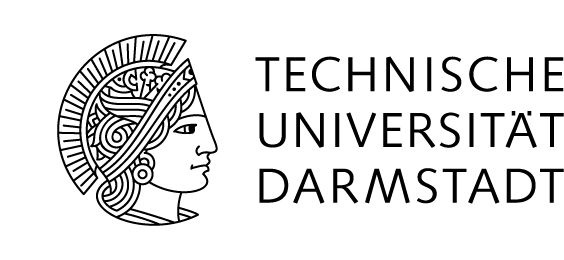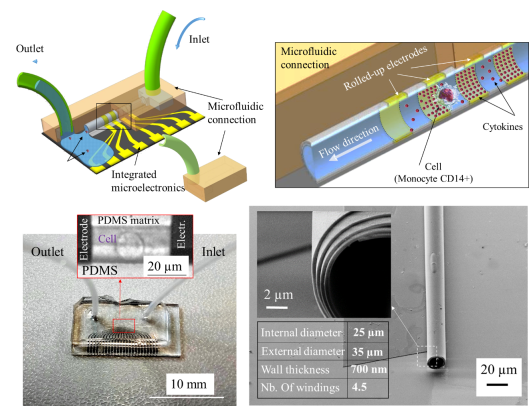Lab-in-a-tube: non-linear dielectric spectroscopy for multiparametric bioanalysis
Phase 2
In this project we focus on the development of a sensor in a tube based on impedance spectroscopy, for the high-throughput analysis of immunological cells and their expressed proteins when experiencing activation due to the presence of a stimuli or foreign material. Dielectric spectroscopy from linear to non-linear range, in the high frequency range, is employed for the multiparametric analysis of such complex biological samples avoiding the use of surface functionalization and labeling steps.
Project management and participating institutes:
Prof. Dr. Oliver G. Schmidt, Institute for Integrative Nanosciences, Leibniz IFW Dresden
Dr. Daniil Karnaushenko, Institute for Integrative Nanosciences, Leibniz IFW Dresden
Dr. Mariana Medina Sánchez, Institute for Integrative Nanosciences, Leibniz IFW Dresden
Research Team:
Dr. Aleksandr Egunov,
Dr. Dmitriy D. Karnaushenko
Dr. Katja Akgün
Nicole Kretschmann
Franziska Hebenstreit
Zehua Dou
Objectives
General objective: Development of a highly sensitive and selective label-free non-linear impedimetric sensor for multiparametric analysis of biological samples (e.g. immunological cells and related biomarkers) using rolled-up microelectrodes.
- Design of the three-dimensional multi-winding sensor in a tube: Fluid dynamics and AC/DC Ansys modules will be used to design and model the electric field as well as fluid dynamics within the tubular electrode and their inter-windings to optimize the fluid handling and to ensure a homogenous electric field for a sensitive detection.
- Fabrication of the rolled-up sensor-in-a-tube and further characterization in both the linear and non-linear spectroscopy range: Strained polymeric layers will be patterned in two dimensions and rolled after etching the sacrificial layer underneath them. In between the windings there will be defined fluidic separations, to take advantage of the small cavities in between them for small molecule analysis.
- Electric characterization of the sensor in a tube: Measurements using biologically-relevant electrolytes will be performed to characterize the proposed sensor and further modeling employing equivalent circuits will be deduced and simulated using e.g. Python/Matlab for the further parametric analysis.
- Quantify and analyze the most relevant analytes related to the immunological cell activation process: Both planar and tubular electrodes will be used to determine individual or multiple biomarkers related to the presence of foreign material (i.e. pathogens) which can trigger the activation of immunological cells and correlate the corresponding non-linear response to particular signatures of the individual analytes.
Abstract
Analytical platforms based on impedance spectroscopy are promising for non-invasive and label-free analysis of single cells as well as of their extracellular matrix, being essential to understand cell function in presence of certain diseases. Here, an innovative rolled-up impedimetric microfluidic sensor is proposed for the simultaneous analysis of single human monocytes and their expressed cytokines upon liposaccharides (LPS)-mediated activation (as a model pathogenic trigger). In particular, rolled-up platinum microelectrodes are integrated into a microfluidic channel for the static and dynamic detection of cells and their expressed cytokines over an excitation frequency range from 102 Hz to 5×106 Hz. The correspondence between cell activation stages and expressed cytokine levels is detected by linear and non-linear EIS in dynamic mode without employing electrode surface functionalization and labeling. The designed sensor-in-a-tube platform is dedicated to be a new tool for precise single cell analysis and fast clinical diagnosis towards early immune-deficient diseases.
Publications
1. D. Karnaushenko, N. Münzenrieder, D. D Karnaushenko, B. Koch, A. K. Meyer, S. Baunack, L. Petti, G. Tröster, D. Makarov, O. G. Schmidt (2015) Biomimetic Microelectronics for Regenerative Neuronal Cuff Implants Advanced Materials, 27, 6797.
2. D. Karnaushenko, D. D Karnaushenko, D. Makarov, S. Baunack, R. Schäfer, O. G. Schmidt (2015) Self‐Assembled On‐Chip‐Integrated Giant Magneto‐Impedance Sensorics, Advanced Materials, 27, 6582.
3. D. Karnaushenko, L. Baraban, D. Ye, I. Uguz, R. G. Mendes, M. H. Rümmeli, J. A. G. M. de Visser, O. G. Schmidt G. Cuniberti, D. Makarov (2015) Monitoring microbial metabolites using an inductively coupled resonance circuit, Scientific Reports, 5, 12878.
4. M. Medina-Sánchez, B. Ibarlucea, N. Pérez, D.D. Karnaushenko, S.M. Weiz, L. Baraban, G. Cuniberti, and O.G. Schmidt (2016), High-performance three-dimensional tubular nanomebranes sensor for DNA detection, Nano Letters, 16, 4288.
5. S. Weiz, M. Medina-Sánchez, and O. G. Schmidt (2018), Microsystems for single cell analysis, Advanced Biosystems, 2, 1700193 (1-32).
6. R. Streubel, J. Lee, D. Makarov, M.-Y. Im, D. Karnaushenko, L. Han, R. Schaefer, P. Fischer, S.-K. Kim, O. G. Schmidt (2014) Magnetic microstructure of rolled-up single-layer ferromagnetic nanomembranes, Advanced Materials, 26, 316. doi: 10.1002/adma.201303003
7. G. Lin, L. Baraban, L. Han, D. Karnaushenko, D. Makarov, G. Cuniberti, O.G. Schmidt (2013) Magnetoresistive emulsion analyser, Nature Scientific Reports, 3, 2548. doi: 10.1038/srep02548
8. M. Melzer, D. Karnaushenko, D. Makarov, L. Baraban, A. Calvimontes, I. Mönch, R. Kaltofen, Y. Mei, O. G. Schmidt (2012) Elastic magnetic sensor with isotropic sensitivity for in-flow detection of magnetic objects, RSC Advanced, 6, 2284. doi: 10.1039/C2RA01062C
9. H. Montón, M. Medina-Sánchez, J.A. Soler, A. Chałupniak, C. Nogués, and A. Merkoçi (2017), Rapid on-chip apoptosis assay on human carcinoma cells based on annexin-V/quantum dot probes, Biosensors and Bioelectronics, 94, 408-414.
10. M. Medina-Sánchez, S. Miserere, E. Morales-Narváez, and A. Merkoçi (2014), On-chip magneto-immunoassay for Alzheirmer’s biomarker electrochemical detection by using quantum dots as labels, Biosensors and Bioelectronics, 54, 279-284.


